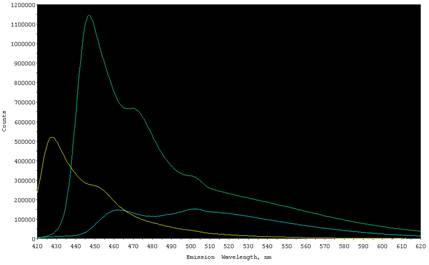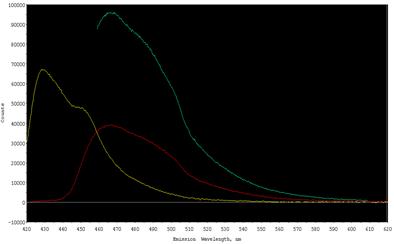www.acsprf.org
Reports: UNI150126-UNI1: Novel N-Heterocyclic Carbenes and their Corresponding Homo- and Heterometallic Complexes
Daniela Tapu, PhD , Kennesaw State University
This year the focus of our research was slightly changed due to solubility problems encountered with our original targets. As agreed earlier this year with our program manager, we are now targeting a different class of N-heterocyclic carbene ligands, ligands that are tagged with fluorescent moieties. We designed our carbenes as supports for mono- and bimetallic complexes. Interest in the development of new carbenes and their corresponding transition metal complexes has arisen due to their potential application in catalysis as fluorescent probes for a variety of catalytic reactions. By attaching florescent tags to the catalyst, the reaction could be monitored by a fluorescence spectrometer.
Compound 2 in the addendum sent earlier this year was obtained by a reaction sequence involving nitration with HNO3/H2SO4, double alkylation, and reduction with Sn/HCl. This compound proved to be an important intermediate for the synthesis of a series of functionalized imidazolium salts (compounds 7, 9 and 11 in the addendum). As anticipated, these compounds display fluorescence properties (Figure 1). The fluorescence spectra are shown in Figure 2.
Figure 1. 10-5 molar solutions for 7, 9, and 11 (BF4 salts) under UV light
Figure 2. Emission spectra for 7, 9, and 11 at 410 nm in CH2Cl2 (1.0 x 10-5 mol l-1).
Our preliminary studies on the reactivity of 7 and 8 indicated that the corresponding rhodium(I) and iridium(I) complexes can be easily generated by in situ deprotonation of 7 and 8 with potassium tert-butoxide in the presence of [M(COD)Cl]2 (M = Rh, Ir). The reactions were conducted at room temperature. These complexes are stable and can be handled in air with no evident decomposition. We are currently investigating the fluorescence emission spectra of these new metal complexes. Our preliminary data shows that the rhodium complexes display fluorescence (Figure 3).
Figure 3. Emission spectra for two Rh complexes at 410 nm (yellow and red) and 445 nm (green) in CH2Cl2 (1.0 x 10-5 mol l-1).
Going forward, we are planning to generate and characterize the free carbenes as well as other metal complexes (palladium, silver and ruthenium). If stable, all the carbenes and their corresponding complexes will be structurally characterized by X-ray diffraction. Further, we plan on monitoring these modified catalysts as they progress through a catalytic reaction (e.g., a palladium complex in a Suzuki reaction).
Support from PRF through this award has been a major asset to my research group. In the last year this grant allowed five undergraduate students to participate in research, in terms of independent studies for credit as well as paid stipends over summer. Chris Ghattas, Mahatab Chowdhury, and Gary Richoux have continued to work on this project for the second year. Gary Richoux graduated in Spring 2011 and he is currently a PhD candidate in Chemistry at Virginia Tech. Chris and Mahatab are graduating this year and they plan on going to graduate school. Two students have joined my research group this summer: Joycellin Foster and Lauren Hutchinson (freshman). Funds provided by PRF have allowed me to offer part-time summer research experiences to three of these students whom I would not otherwise have been able to hire: Mahatab, Joycellin, and Lauren.
Gary, Mahatab, and Chris have presented the initial results of our work at the Southeast Regional Meeting of the American Chemical Society in New Orleans, LA (Fall 2010). Chris, Lauren, and Mahatab will travel to Richmond Virginia to present at SERMACS in October 2011. Lauren will also present her results at the 6th Annual Fall National Symposium and Research Conference in Savannah (October 14-15, 2011).
Due to his academic achievements and his involvement in undergraduate research, Chris was the Chemistry Department's recipient of the ACS Undergraduate for Achievement in Organic Chemistry and The Polyed Undergraduate Award for Achievement in Organic Chemistry in Spring 2011. Chris and Mahatab maintained their eligibility for NSF scholarships and each of them is now the recipient of a Regional Meeting Travel Award. These awards will pay for their travel expenses to present at SERMACS.
Finally, this award strengthened my tenure and promotion portfolio. I am now tenured. This grant was also one of the contributing factors behind my receiving of the Kennesaw State University Foundation Prize for Publication two years in a row. This prize comes with significant funds for professional development and research.
The data that my students and I have collected over the past year will form the backbone of a manuscript that I plan to submit during summer 2012.
Conference presentations that have acknowledged this award:
· Tapu, Daniela; Ghattas, Christopher; Richoux, Gary; Chowdhury, Mahatab; Kummerow, Gerhard Novel bimetallic complexes derived from N-heterocyclic carbene 241st ACS National Meeting, Anaheim, CA, United States, March 27-31, 2011
· Daniela Tapu, Uyen Do, Chris Ghattas, Mahatab Chowdhury, Gerhard Kummerow N-heterocyclic carbenes: Ligands for redox switchable catalysts 66th Sounthwest and 62nd Southeastern Regional Meeting of the American Chemical Society, December 3rd, 2010
· Daniela Tapu, Gary Richoux, G. Kummerow New polycyclic N-heterocyclic carbenes and their transition metal complexes 66th Sounthwest and 62nd Southeastern Regional Meeting of the American Chemical Society, December 3rd, 2010
· Christopher Ghattas, Mahatab Chowdhury, Daniela Tapu "Toward the development of new redox-switchable catalysts" 16th Symposium of Student Scholars & Undergraduate Research, Kennesaw State University, April 26, 2011, Kennesaw, GA
· Gary Richoux, Christopher Ghattas and Mahatab Chowdhury, Daniela Tapu Toward novel bimetallic complexes derived from N-heterocyclic carbenes 16th Symposium of Student Scholars & Undergraduate Research, Kennesaw State University, April 26, 2011, Kennesaw, GA



